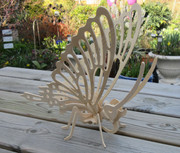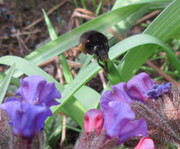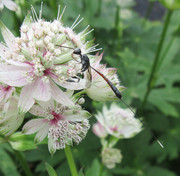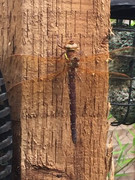|
|
Post by maggy on Mar 26, 2019 7:55:58 GMT
Love your butterfly Tig, don’t like your bug Rosefriend, harmless or not.  |
|
|
|
Post by Ladygardener on Mar 26, 2019 10:03:42 GMT
I made this today, it does count as an 'insect in the garden'   It's really good Tig, are you going to paint it? |
|
|
|
Post by Tig on Mar 26, 2019 16:13:42 GMT
Rosefriend, Ladygardener I am going to leave it in the garden, but thought I might paint it, although I'm not sure if acrylics will last long outside. I'll see how I feel when it's been out a few days, it's already blown over twice in the wind 
|
|
|
|
Post by Jasmine on Mar 26, 2019 19:02:11 GMT
Very delicate Tig! Have to share this - there was a bee fly on the steps down to the sand pit today and the children watched it fascinated - it has such a long nose/proboscus(?). I was even able to tell them what it was - never seen or heard of one until you mentioned them! I learnt something new the other day and today my TA and 3 children learnt something new too! |
|
|
|
Post by Tig on Mar 26, 2019 19:08:07 GMT
That's lovely to hear Jasmine - I learn something new almost every day despite my age. Today I learnt that there is another type of bee fly which has spotted wings called the Dotted Bee Fly (bombylius discolor)! I would love to find one of those too but they are largely confined to the South of England and South Wales coasts evidently. |
|
|
|
Post by Jasmine on Mar 26, 2019 19:31:43 GMT
I've got everything peeled - they are the cutest little fluffy things - the beaky thing looks a bit frightening but I don't think they sting do they? It was enjoying the sunshine immensely!
|
|
|
|
Post by Tig on Mar 27, 2019 12:31:20 GMT
Totally harmless to humans Jasmine, the proboscis is used for feeding on tubular spring flowers. Look out for the hairy footed flower bees visiting pulmonaria - they also have a long proboscis but are very quick little fliers, the females are all black with ginger rear legs and the males are a buff beige and are often seen following the females hoping to mate. They are notoriously difficult to get a decent photo of though because they only land for seconds. Best one I've managed of a female this year is this  |
|
|
|
Post by Jasmine on Mar 27, 2019 18:30:09 GMT
Men!   That's pretty impressive Tig! |
|
|
|
Post by Ladygardener on Mar 30, 2019 7:49:50 GMT
I was delighted to catch a pic of this peacock butterfly this week in the garden. I rarely see them.  |
|
|
|
Post by Ladygardener on May 28, 2019 6:25:43 GMT
Last week on the Hydrangea. Little baby spiders.   |
|
|
|
Post by Missredhead on May 28, 2019 12:37:30 GMT
That made me itch Ladygardener....
|
|
|
|
Post by Ladygardener on May 29, 2019 6:41:32 GMT
You should have seen them scurrying around when I touched them, at first I did'nt realise what they were Missredhead! |
|
|
|
Post by Tig on Jun 26, 2019 18:56:04 GMT
An odd visitor today ...  Can't recall seeing one in the garden before, but easy to miss I suppose. It's called gasteruption jaculator (yes really!  ) |
|
|
|
Post by Ladygardener on Jun 27, 2019 6:53:03 GMT
Wow!! Tig. I found this moth the other day, the wings are iridescent amazing and the pic does'nt do it justice. I think it's Scotopteryx chenopodiata.  |
|
|
|
Post by Ladygardener on Jul 10, 2019 16:24:26 GMT
I noticed these 2 in the garden yesterday. I've never seen a spider like this one and have no idea what it is. The Moth I've seen a few years back and I think it's a Burnet.   |
|
|
|
Post by Tig on Jul 10, 2019 18:55:13 GMT
Your moth is a 5 spot burnet I think LG, and you've got a woodlouse spider.
|
|
|
|
Post by Rosefriend on Jul 11, 2019 7:18:30 GMT
Never heard of a woodlouse spider and blimey - I do not want one here!!
|
|
|
|
Post by Ladygardener on Jul 11, 2019 8:28:16 GMT
Thanks very much for the identification Tig. I'll be sending the pics to the boys and girls on whatsapp later and it will be good to tell them what they are. |
|
|
|
Post by stevemc on Aug 5, 2019 9:25:17 GMT
 First time I’ve seen one of these here |
|